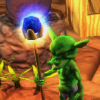I'd say, upload a .blend file somewhere so we can take a look at it.
At any rate, try this as an experiment:
1) Open Blender, select the default cube, TAB into edit mode, select all vertices, press 'u' and select "Unwrap". This will assign UVs to the first default UV layer. Each face of the cube will be mapped to the entire (0,0)->(1,1,) range of the UV. You can see the UV layout in the UV editor; it should consist of a single square outlining the active UV region; all faces are stacked on top of one another. This will map the entire texture to every face of the cube.
2) With the cube still selected, go to the Object Data menu tab. Under the UV Maps tab, select the '+' button to add another UV layer. Click on the new UV layer to select it.
3) Again, with the Cube still selected and still TABbed into edit mode, press 'u'. Here, select 'Lightmap pack'. You can go into UV Editor again to see the effect of this operation. The new UV layer is laid out as an atlas, with all six faces of the cube packed into the texture and non-overlapping.
4) Create a material for the cube if it does not already have one.
5) Add a texture to the material. Under the Texture tab after the texture is added, select Image for the texture type and load up some random old image. Underneath the Mapping sub-tab in Texture, change the Coordinates field from Generated to UV. Doing this will add a box labeled Map underneath the Coordinates line. Select the icon in the box, and from the pop-up list select the first UV Layer (the one with the full-texture UV layout, not the atlas). This selects the set of UV coords to map the texture from.
6) Under Object Data, select the second UV Layer, the one with the atlas layout.
7) Still TABbed into Edit Mode, go into the UV Editor. You should see the atlas UV layout.
8) At the bottom of the UV Editor, select New to create a new image, choose dimensions for it, and select Ok. A new image will be created, and now the UV layout will appear over a black background.
9) Go into the Render menu, Bake subtab. From the drop-down menu labeled Bake Mode, select the type of baking you want to do. (For example, select Texture; this will bake diffuse texture info)
10) Hit Bake. The image that you created with the second UV Layer selected will be gradually filled with pixels baked from the material. You should see the texture that you assigned to all the faces in the material, duplicated six times to correspond to the atlas layout in the second UV Layer. From the UV Editor, you can save this image to file. In the same manner, you can bake all of your maps (ambient occlusion, normal, etc...) and save them to image files.
Bloody Blender Nightmare
jTippetts! That worked! Words cannot express how appreciative of the time you spent working with me to help me through this. Very much, without doubt, and beyond all words excited to get past this problem.
Thank you, thank you, thank you!
[sharedmedia=gallery:images:2323] End Product after overcoming the texture problem.
Thank you, thank you, thank you!
[sharedmedia=gallery:images:2323] End Product after overcoming the texture problem.
This topic is closed to new replies.
Advertisement
Popular Topics
Advertisement
Recommended Tutorials
Advertisement






